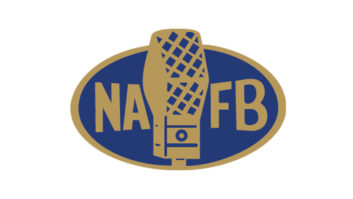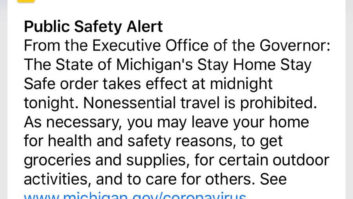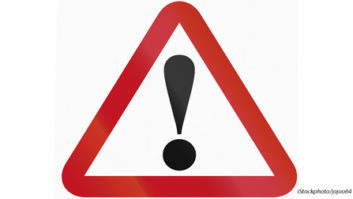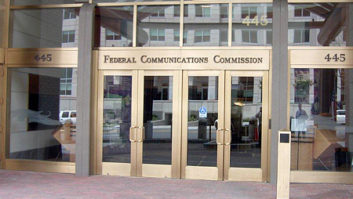The author is broadcast chair of the Wisconsin State Emergency Communications Committee.

In February the annual EAS Forum, sponsored by the National Alliance of State Broadcasters Associations and the National Association of Broadcasters, was held in Washington. In attendance were officials from the Federal Communications Commission, the Federal Emergency Management Agency and the National Weather Service.
A number of pertinent EAS issues were discussed.
NEXT NATIONAL EAS TEST
FEMA announced that the next nationwide EAS test will be conducted on Wednesday, Sept. 28, 2016 at 2:20 p.m. EDT.
This test will use the National Periodic Test (NPT) event code and the National location code, 000000. FCC rules becoming effective on July 30, 2016 require that all EAS Participants immediately relay this test.
Results of the test must be reported by each EAS Participant into the FCC’s Electronic Test Reporting System, which the FCC stated in the meeting they are targeting for launch in June. EAS Participants will then have 60 days to enter their initial data described in the EAS rules, in advance of the national test.
STATE EAS PLANS
In the current EAS Notice of Proposed Rulemaking released on Jan. 29, 2016, the FCC proposes to have all State EAS Plans submitted online. In the meeting, the commission stated that they want State Emergency Communications Committees to continue to submit updated State EAS Plans, and if the online plan proposal is adopted they will ingest the current plan files into the online portal.
The NPRM proposes to widen the scope of State EAS Plans by including details on state use of Wireless Emergency Alerts, highways signs and social media. The FCC clarified that it doesn’t intend to require all states to implement these alerting methods, but wants to leave room for innovation by states that want to do so. The FCC also noted that it is concerned about the lack of cable operator participation on many SECCs.
The commission agreed with a suggestion that the topic of drafting needed members onto SECCs be taken up by a future Communications Security, Reliability and Interoperability Council, which is an FCC federal advisory group that provides recommendations to the commission.
NWS EAS ALERTS VIA THE IPAWS EAS FEED
Currently, the NWS is not sending weather alerts over the Integrated Public Alert and Warning System (IPAWS) EAS feed, because of issues with the inability to detect duplicates of the same alert issued in legacy EAS over NOAA Weather Radio vs. the Common Alerting Protocol (CAP) version.
Although NWS is currently deploying new software for controlling NWR, called Broadcast Message Handler (BMH), this upgrade will still only be a partial step to curing the duplicate alert detection issue. NWS is interested in a recommendation by a past CSRIC group to add an identification tag to EAS messages to cure this issue, and will likely propose such a solution in its NPRM comments.
NWS was also questioned as to whether the new BMH software will now allow NWR to carry the president’s Emergency Action Notification (EAN) EAS message. NWS responded that BMH is a stepping stone, but not a full solution. However, NWS, FEMA and FCC will continue to work toward that goal.
CSRIC EAS PROGRESS
The current CSRIC Working Group is making progress with recommendations to the commission on three EAS topics: fostering adoption of EAS security best practices by EAS Participants, updating the EAS Operating Handbook and multilingual EAS alerting. The reports of these groups will be delivered to the FCC at the March and June CSRIC meetings.
PEP UPGRADES
FEMA reported that some new Primary Entry Point stations were added over the last two years, and now the focus is on modernizing the 30-some original PEP stations to replace their aging equipment. In addition, FEMA has now transitioned to satellite-based delivery of the EAN message to PEP stations, which also allows two-way communications with individual stations.
FILE YOUR COMMENTS
The FCC acknowledged that there are a lot of proposals and requests for comment in the current EAS NPRM, and at many points during the meeting stressed that they want official comments submitted by all parties in the EAS community.
The commission has stated many times in the past that they do not make decisions on adopting new rules based on their own judgement; decisions are always based on the comments received — whether for or against any particular FCC proposal.
Don’t just sit in your chair saying, “That’s a great idea” or conversely, “That’s a terrible idea” — make your comments known. Especially, don’t presume that something is so obviously right or wrong that comment isn’t needed; the EAS community has gotten caught in the past by not commenting and after the FCC implemented the rule they rescinded it after an uproar.
Please state your opinions, it’s easy — see www.fcc.gov/ecfs.












